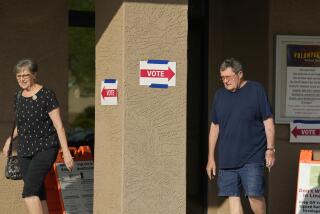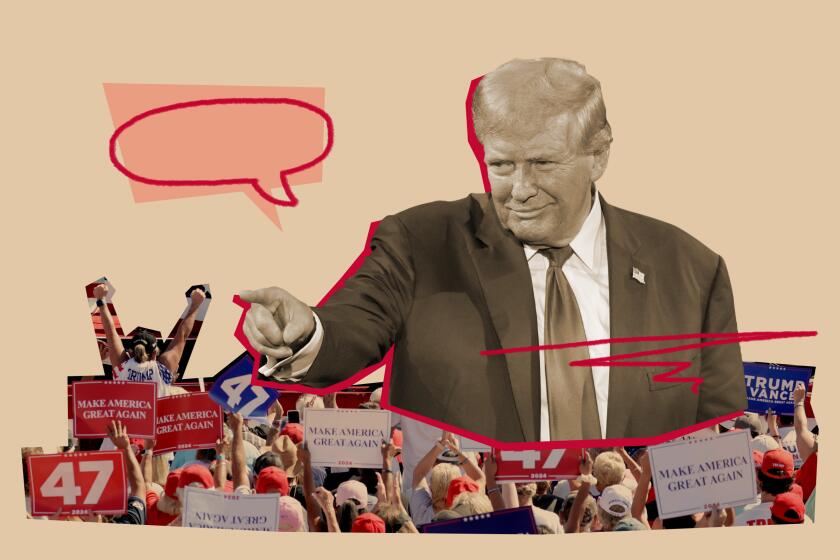Perot Bid Given Good Odds : Politics: Texas billionaire’s effort to set up a new national party faces formidable obstacles, but pundits give him the benefit of the doubt.
Although California looms as a formidable first obstacle to Ross Perot’s bid to create a new national party, state political experts gauging his odds of success give him the benefit of the doubt.
The passion for the type of reform-minded party Perot envisions clearly exists in the state, they say. The big question, they add, is organizational--can the Texas billionaire mobilize the foot soldiers needed to qualify the party for California’s 1996 ballot in less than a month?
The first indicators of Perot’s success on this front should emerge this weekend, as he travels through the state to stir up support and set in motion the drive to establish the party.
The effort got rolling Friday night in San Diego, where Perot addressed the first of five weekend workshops designed to energize volunteers and teach them the nuts and bolts of voter registration and petition circulation.
Perot’s initiative is drawing upon many veterans of the state petition drive that qualified him as an independent presidential candidate in 1992. At that time, the Perot organization claimed that it collected 1.4 million signatures in little more than two months, but that figure was never verified because the secretary of state’s office stopped counting after they reached the requisite 467,451.
The other Perot-attended workshops are to be held today in Buena Park and Santa Clara and Sunday in Sacramento and Marin County. An official with United We Stand America--the group Perot set up in the wake of his ’92 race--said it is likely that most of the work required to qualify the new party will be done in heavily populated Los Angeles, Orange and San Diego counties.
Under state election law, either of two methods can be used to qualify the party: signing up 89,007 new party members through voter registration or gathering 890,064 signatures of registered voters on petitions. The numbers are daunting enough, but the time element is the potential party-breaker--whichever qualifying process Perot and his supporters decide upon, the work must be submitted to state officials by Oct. 24.
At first blush, California political pundits pronounced this task impossible, or virtually so. Comparable petition campaigns to qualify measures for the ballot--a frequent occurrence--usually take months, involve the use of professional signature collectors and can cost $1 million or more.
But as the experts contemplated Perot’s proposal, as well as the core of support he has continued to enjoy since his independent candidacy, none of those interviewed was willing to bet that he would fail to qualify the Reform Party--its temporary name in the state--by the approaching deadline.
“That’s a very difficult job, but it can be done,” said Darry Sragow, a Democratic political consultant in Los Angeles. “It takes a lot of money and a lot of people.”
Perot claims there are plenty of people. And observers assume he will personally make sure there is enough money.
Perot said in an interview this week that there has been an overwhelming response to the idea of a new party, which he unveiled on a television interview program Monday night. The group, to be known on the national level as the Independence Party, would be a vehicle for a candidate to challenge the Democratic and Republican presidential nominees. Perot, who in his 1992 campaign won 21% of the vote in California and 19% nationwide, has insisted he is not interested in being that candidate.
The California political experts view the registration process as the best certification route for Perot and his supporters to follow. “The getting of 90,000 people registered seems totally feasible,” said Robert Nelson, chairman of Nelson and Lucas, a statewide political public relations firm.
Conversely, the experts were skeptical of the wisdom of trying the alternative qualifying method--collecting the valid signatures of almost 900,000 registered voters.
Petition campaigns routinely collect far more signatures than the target number to compensate for invalid names thrown out by elections officials, usually because the signees are not registered voters. Given that, Sragow and others said the Perot organization actually would need to collect more than 1 million signatures.
*
Despite that advice, Perot continued to emphasize the petition process.
He noted that petition forms will be printed in Sunday newspapers in California cities.
Platt Thompson, executive director of United We Stand in California, said that initially both certification procedures would be followed “to find out which works better.”
As for the cost of the campaign and its financing, Thompson said: “You got me. The work is being done by volunteers. People are calling in left and right. The primary cost is the postage of getting the petitions to them.”
California’s qualifying deadline for the 1996 ballot comes early because the Legislature moved next year’s primary from the first Tuesday in June to March 26 in an attempt to make the state a bigger player in the presidential nominating process. Because state law requires a party to be qualified at least 135 days before the primary, that pushed the deadline into this year.
Times Washington Bureau Chief Jack Nelson and staff writer Michael Granberry contributed to this story.
(BEGIN TEXT OF INFOBOX / INFOGRAPHIC)
Creating a New Party
A state-by-state look at requirements for certifying a new political party capable of nominating a presidential candidate:
1995
California: 890,064 signatures of registered voters by Oct. 24. Or, 89,007 people must register as members of the new party by Oct. 24.
Maine: 25,551 signatures by Dec. 14.
Ohio: 33,463 signatures by Nov. 20.
1996
Alabama: 11,991 signatures by Sept. 2.
Alaska: 2,586 signatures by undetermined date.
Arizona: 15,062 signatures by May 21.
Arkansas: 21,506 signatures by Jan. 2.
Colorado: No procedure.
Connecticut: No procedure.
Delaware: 180 signatures of registered voters by Aug. 17.
District of Columbia: No procedure.
Florida: 196,788 signatures by July 16.
Georgia: 30,036 by July 9.
Hawaii: 4,889 signatures by April 24.
Idaho: 9,644 signatures by Aug. 31.
Illinois: No procedure.
Indiana: No procedure.
Iowa: No procedure.
Kansas: 16,417 signatures by April 11.
Kentucky: No procedure.
Louisiana: New party must register 5% of registered voters by June 30 or have a candidate get at least 5% of the vote in a general election.
Maryland: 10,000 signatures by Aug. 5.
Massachusetts: 34,000 signatures of registered voters by July 1.
Michigan: 30,891 signatures by July 18.
Minnesota: 89,731 signatures by May 1.
Mississippi: Must be organized by April 1.
Missouri: 10,000 signatures by Aug. 5.
Montana: 10,471 signatures by March 14.
Nebraska: 5,741 signatures by Aug. 1.
Nevada: 3,761 signatures by July 11.
New Hampshire: No procedure.
New Jersey: No procedure.
New Mexico: 2,339 signatures by July 9.
New York: No procedure.
North Carolina: 51,904 signatures by undetermined date.
North Dakota: 7,000 signatures by April 12.
Oklahoma: 49,751 signatures by May 31.
Oregon: 18,316 signatures by Aug. 27.
Pennsylvania: No procedure.
Rhode Island: 18,069 signatures by Aug. 1.
South Carolina: 10,000 signatures by May 5.
South Dakota: 7,792 signatures by April 2.
Tennessee: 37,179 signatures by May 1.
Texas: 43,963 signatures by May 23.
Utah: 500 signatures by Jan. 2.
Vermont: Must be organized by Sept. 19.
Virginia: No procedure.
Washington: No procedure.
West Virginia: No procedure.
Wisconsin: 10,000 signatures by June 1.
Wyoming: 8,000 signatures by May 1.
NOTE: Some states have no procedure by which a new party can qualify before it chooses candidates. In those states, supporters of a specific candidate follow a separate procedure to put that person on the ballot.
Source: Ballot Access News, Associated Press
More to Read
Get the L.A. Times Politics newsletter
Deeply reported insights into legislation, politics and policy from Sacramento, Washington and beyond. In your inbox three times per week.
You may occasionally receive promotional content from the Los Angeles Times.










